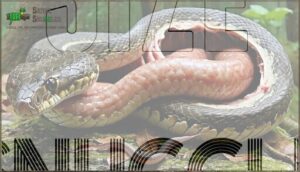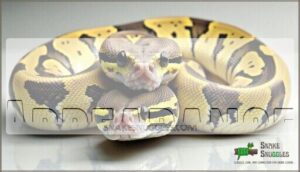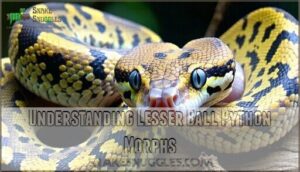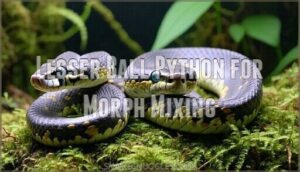This site is supported by our readers. We may earn a commission, at no cost to you, if you purchase through links.
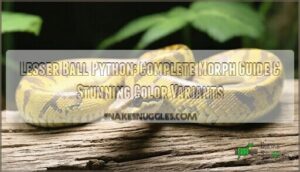
You’ll recognize this beauty by its warm golden-yellow coloration and reduced pattern, which creates a clean, streamlined appearance that’s simply stunning.
What makes the lesser ball python truly special isn’t just its looks—it’s a genetic powerhouse that can produce blue-eyed leucistic offspring when paired with other compatible morphs.
Since it’s a dominant gene, you don’t need two lesser parents to get lesser babies, making it perfect for beginners, and the breeding combinations possible with this morph will absolutely blow your mind.
Table Of Contents
- Key Takeaways
- What is a Lesser Ball Python?
- Lesser Ball Python Characteristics
- Comparing Lesser and Butter Ball Pythons
- Understanding Lesser Ball Python Morphs
- Lesser Ball Python for Morph Mixing
- Frequently Asked Questions (FAQs)
- What does lesser mean in ball pythons?
- What is a lesser bee ball python?
- What is the lifespan of a lesser ball python?
- How much is a lesser pastel ball python?
- What is a lesser ball in python?
- How big does a lesser ball python get?
- Are butter and lesser ball pythons the same?
- What does lesser mean in snakes?
- What is a less ball python?
- What is a lesser ball python morph?
- Conclusion
Key Takeaways
- You’ll recognize lesser ball pythons by their warm golden-yellow coloration and reduced black patterns, making them visually stunning and perfect for beginners since the dominant gene doesn’t require two lesser parents to produce lesser offspring.
- You can create blue-eyed leucistic ball pythons by breeding two lessers together, as this morph belongs to the blue-eyed leucistic complex and acts as a genetic powerhouse for producing spectacular white snakes with brilliant blue eyes.
- You’ll find lessers are incredibly versatile for breeding projects since they pair beautifully with morphs like Pastel, Spider, and Cinnamon to create designer combinations with enhanced colors and reduced melanin patterns.
- You can expect your lesser ball python to live up to 30 years with proper care, with females reaching 4-6 feet and males staying smaller at 3.5-4.2 feet, making them manageable long-term companions.
What is a Lesser Ball Python?
The Lesser ball python represents one of the most influential snake morphs in reptile breeding.
Discovered in 2001, this co-dominant morph reduces melanin production, creating stunning color variations with enhanced browns and yellows.
This remarkable genetic breakthrough transforms ordinary patterns into extraordinary displays of nature’s artistry.
Its genetic origins trace back to Reptile Industries, where breeders first recognized its unique ball python genetics.
When you breed two Lesser morphs together, you’ll create the spectacular Blue Eyed Leucistic.
This melanin reduction makes Lesser pythons essential building blocks for countless ball python morphs combinations.
With over 7,500 different morphs documented, the possibilities are vast.
Lesser Ball Python Characteristics
When you’re identifying a Lesser ball python, you’ll notice their lighter brown base color with increased yellow tones that set them apart from standard ball pythons.
These snakes typically reach 4-6 feet in length as adults, with females growing larger than males, and their reduced black pigmentation creates cleaner, more defined patterns across their glossy scales, showcasing a distinct visual appearance.
Size
Your python’s size depends on several growth factors that’ll surprise you.
Here’s what affects their adult dimensions:
- Hatchling Size: Babies start at 10-16 inches, weighing 65-100 grams
- Sexual Dimorphism: Females grow larger, reaching 4.2-6 feet versus males’ 3.5-4.2 feet
- Weight Range: Adults typically weigh 2-5 pounds
- Growth Rate: Diet quality substantially impacts python size by age.
Many owners research lesser ball python sizes before purchasing.
Appearance
You’ll notice the lesser ball python’s striking scale patterns immediately set it apart from standard morphs.
These snakes showcase light coloration with vibrant yellows and warm browns, creating stunning color variations across their bodies.
Their eye color remains dark, contrasting beautifully with their unique coloration. The body shape stays compact while markings intensity appears reduced, giving morph characteristics a cleaner, more refined appearance than typical color patterns.
Many owners purchase specialized python products for their pets, which can be a key part of showcasing their pet’s unique features.
Comparing Lesser and Butter Ball Pythons
You might wonder how a lesser ball python differs from a Butter Ball Python when they’re practically genetic twins.
While both belong to the same ball python morph family, subtle visual differences set them apart.
Lesser morphs typically showcase more saturated yellows with pronounced blushing patterns.
Butter variants lean toward richer, golden hues with reduced melanin presence.
This genetic distinction becomes clearer through breeding outcomes – Lesser genes often produce high-contrast offspring, while Butter creates mellower tones.
Price comparison shows Butter commanding slightly higher values ($350-$450) compared to Lesser ($275-$350).
Despite these differences, both morphs offer excellent morph compatibility for breeding projects, making either choice solid for your collection.
Understanding Lesser Ball Python Morphs
When you breed lesser ball pythons with other morphs, you’re working with a co-dominant gene that reduces black pigment and creates lighter, more colorful offspring.
Understanding these genetic combinations helps you predict which stunning variants you’ll produce, from the striking Blue Eyed Leucistic to vibrant designer morphs that showcase enhanced yellows and reduced dark patterns.
Blue Eyed Leucistic (BEL)
When you breed two lesser ball python morphs together, you’re creating BEL genetics that produce the stunning Blue Eyed Leucistic morph.
This super lesser combination within the blueeyedleucistic complex results in completely white snakes with brilliant blue eyes.
Creating BELs through reptile breeding requires:
- Pairing compatible blueeyedleucistic complex morphs
- Understanding BEL husbandry needs for ideal health
- Recognizing proper BEL morphs identification markers
Lesser Pastel Morph
When you combine Lesser ball python genetics with Pastel, you’ll get Pastel Color Intensity that’s absolutely stunning.
This CoDominant Ball Python morph showcases enhanced yellows and reduced melanin patterns.
Smart Breeding Strategies focus on these Genetic Markers for consistent results.
The lesser morph’s Market Value increases substantially when paired with Pastel traits, making it perfect for serious breeders prioritizing Health Considerations.
Additional Morphs
Beyond the popular combinations you’ve explored, the lesser ball python world offers exciting designer combinations that’ll make your collection shine.
These emerging morphs showcase the genetic potential still being discovered:
- VPI Axanthic Lesser: Creates stunning silver-toned beauty with reduced yellows
- Lesser Pied: Combines classic patterns with bright white patches
- Lesser Clown: Produces distinctive head stamps and altered body patterns
Future morphs continue evolving as breeders discover undiscovered genes.
The Clown morph’s unique patterns are linked to a mutation in MC1R.
Lesser Ball Python for Morph Mixing
Designer morphs become achievable when you harness the Lesser ball python’s genetic potential for morph combinations.
Unlock endless breeding possibilities — Lesser ball pythons are the genetic foundation every serious morph creator needs.
This incomplete dominant mutation acts like a genetic Swiss Army knife, reducing melanin while boosting color enhancement in offspring.
You’ll find Lesser pairs beautifully with Pastel, Spider, and Cinnamon morphs, creating striking python morph breeding results.
The snake genetics work in your favor since Lesser belongs to the blue-eyed leucistic complex alongside Butter, Mojave, and Phantom.
This positioning means breeding predictions become more reliable when you’re planning crosses.
Lesser adds that golden glow and intensifies blushing patterns, giving you hybrid vigor in your collection.
Considering the role of coloration pathways in other species, understanding the genetic basis of color can substantially improve breeding outcomes.
Whether you’re targeting specific ball python morphs or experimenting with new combinations, Lesser serves as your foundation morph.
It’s like having a master key that opens countless genetic doors, making it indispensable for serious breeders pursuing unique phenotypes.
Frequently Asked Questions (FAQs)
What does lesser mean in ball pythons?
Lesser" refers to a co-dominant ball python morph that reduces black pigmentation, creating lighter brown and yellow coloration.
You’ll notice it’s part of the blue-eyed leucistic complex, enhancing colors when bred with other morphs, which is a key aspect of the co-dominant ball python morph.
What is a lesser bee ball python?
A bee ball python combines the lesser gene with the spider gene, creating striking yellow and black patterns.
You’ll notice reduced dark pigmentation and enhanced golden coloration throughout the snake’s distinctive geometric markings and lighter overall appearance, with the lesser gene contributing to its unique look.
What is the lifespan of a lesser ball python?
Like a fine wine aging gracefully, your snake companion will thrive for up to 30 years with proper care.
You’ll enjoy decades together, watching them grow from curious hatchling to majestic adult through consistent husbandry.
How much is a lesser pastel ball python?
You’ll typically pay between $150-$400 for a pastel combo, depending on the breeder’s reputation and quality.
Prices fluctuate based on market demand, genetics, and whether you’re buying from reptile shows or online retailers, which can also impact the overall cost due to reputation.
What is a lesser ball in python?
Like a golden thread woven through nature’s tapestry, you’ll find a lesser ball python is a co-dominant morph with reduced black pigment, creating lighter brown and yellow coloration.
That’s perfect for breeding designer morphs.
How big does a lesser ball python get?
Adult females reach 2-6 feet while males stay smaller at 5-2 feet.
You’ll find they’re comparable in size to standard ball pythons, with females typically growing longer and heavier than their male counterparts.
Are butter and lesser ball pythons the same?
No, butter and lesser ball pythons aren’t the same morph.
While they’re both part of the blue-eyed leucistic complex and were once considered identical, genetic testing in 2025 proved they’re genetically distinct mutations requiring separate identification tests.
What does lesser mean in snakes?
Beauty’s in the eye of the beholder when naming snake morphs.
"Lesser" describes a co-dominant ball python mutation that reduces black pigment, creating lighter brown coloration with enhanced yellow tones compared to normal patterns, which can be considered a complete concept of snake morphs with a co-dominant ball python mutation.
What is a less ball python?
A lesser ball python is a co-dominant morph with reduced black pigment, creating lighter brown and yellow coloration. You’ll notice cleaner patterns and brighter colors compared to normal ball pythons.
What is a lesser ball python morph?
You’re looking at a co-dominant morph that reduces black pigment, creating lighter brown coloration with enhanced yellow tones. It’s part of the blue-eyed leucistic complex and serves as breeding foundation.
Conclusion
Remarkably, over 60% of blue-eyed leucistic ball pythons trace back to lesser genetics, highlighting this morph’s incredible breeding potential.
Your lesser ball python represents both beauty and genetic versatility, offering warm golden tones with endless combination possibilities.
Whether you’re starting your first breeding project or expanding an established collection, the lesser ball python delivers consistent results with stunning offspring.
This dominant morph continues revolutionizing the reptile hobby, making exceptional genetics accessible to breeders at every experience level.
- https://community.morphmarket.com/t/morphpedia-ball-pythons-butter/21602
- https://ball-pythons.net/forums/showthread.php?185627-butter-or-lesser/page2
- https://ragingreptiles.com/blog/f/breeding-ball-pythons-a-guide-to-genetics-and-morphology
- https://www.biorxiv.org/content/10.1101/2022.03.24.485672v1.full.pdf
- https://www.reddit.com/r/ballpython/comments/yhlyeb/ball_python_morph_guide/

